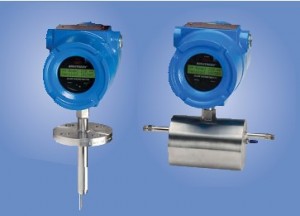Ethanol, or ethyl alcohol, is a highly versatile fluid which has a wide variety of applications ranging from use as an alternative to fossil fuels, to cleaning/sanitizing, and as a solvent for extraction of compounds from plants such as for essential oils. The worldwide demand for ethanol continues to be strong, with over 1 million barrels/day being produced.
Ethanol is produced in a complex process involving both fermentation and distillation. Thermal mass flow meters, such as the Rheotherm Model 210 (pictured here), are used to measure air flow and fuel flow going into the distillation tanks to control the air-fuel ratio which improves combustion.  In processes where ethanol is used as a cleaner or solvent, these same flow meters are used to accurately and reliably measure ethanol flow or miscella fluid flow (extraction applications) for control of the process or to determine rates of consumption or recovery of the ethanol. The ability of Rheotherm Model 210 flow meters to be used for measuring both liquids and gases allows for standardization of instrumentation throughout the process.
In processes where ethanol is used as a cleaner or solvent, these same flow meters are used to accurately and reliably measure ethanol flow or miscella fluid flow (extraction applications) for control of the process or to determine rates of consumption or recovery of the ethanol. The ability of Rheotherm Model 210 flow meters to be used for measuring both liquids and gases allows for standardization of instrumentation throughout the process.
An additional benefit of the Rheotherm Model 210 is that it is available in explosion-proof and intrinsically-safe configurations for safe operation in potentially hazardous environments that are typical in applications where ethanol is used or produced. Click here for more information on using Rheotherm Flow Meters in hazardous environments.
One typical configuration used is a Model 210-XDT-TUL1/4(SS)(MNPT)-4/20-24V-FM. The features of this instrument include: local display readout, 4-20mA analog output, stainless steel wetted material with an unobstructed flow path, and stainless steel sensor housing in an FM/ATEX/IECEx-approved explosion-proof configuration.
For more information about the full line of Rheotherm Model 210 flow meters, visit the flow measurement instruments overview page or contact us using the form on this page.
Rheotherm advantage: accurate low flow measurement of liquids and gases, low pressure drop, intrinsic safety
